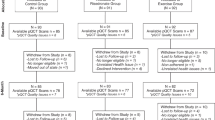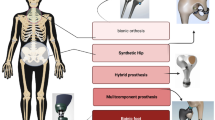Abstract
Hip bone is a robust and complex skeletal structure in the human body and it bears loads while doing the daily activities such as walking, running, etc., by connecting the leg with the torso. The geometry of the hip bone facilitates upright gait in humans and hence its evolution might have been influenced by the mechanical forces acting on it. Previous research works on hip bone mainly concentrated upon its analysis using methods like finite elements. However, no work is reported on the geometric optimization of the hip bone, i.e., how optimal is the geometry of the hip bone under mechanical loads of activities of daily living (ADL). Hence, in this work we explore the optimal geometry of the hip bone during two ADLs, walking, and sit-to-stand. This is posed as the topology optimization problem of compliance minimization of the hip bone under mechanical loads of walking and sit-to-stand. With a view to applications in prosthesis and hemiarthroplasty, we impose equality in volume constraint as the natural hip bone, and guide the optimal designs to generate the hole (obturator foramen in the natural hip bone) in the optimal designs. This is done by using a designer guided approach that consists of a two-step optimization procedure: first selecting results from topology optimization for a particular activity that give high shape similarity with natural hip bone, and then using it as input to topology optimization with loads from the other activity, for example, applying sit-to-stand loads on optimal design from walking. We demonstrate that this designer guided approach leads to exploration of the design space with a reduced set of inputs and increase in shape similarity of the final design with the natural hip bone.
















Similar content being viewed by others
References
Haq, R., Srivastava, A., Dhammi, I.: Classification of pelvic fractures and its clinical relevance. J. Orthop. Traumatol. Rehab. 7(1), 8–13 (2014)
Goel, V.K., Svensson, N.L.: Forces on the pelvis. J. Biomech. 10(3), 195–200 (1977)
Goel, V.K., Valliappan, S., Svensson, N.L.: Stresses in the normal pelvis. Comput. Biol. Med. 8(2), 91–104 (1978)
Dostal, W.F., Andrews, J.G.: A three dimensional biomechanical model of hip musculature. J. Biomech. 14(11), 803–812 (1981)
Bergmann, G., Graichen, F., Rohlmann, A.: Hip joint loading during walking and running, measured in two patients. J. Biomech. 26(8), 969–990 (1993)
Dalstra, M., Huiskes, R.: Load transfer across the pelvic bone. J. Biomech. 28(6), 715–724 (1995)
Anderson, A.E., Peters, C.L., Tuttle, B.D., Weiss, J.A.: Subject-specific finite element model of the pelvis: development, validation and sensitivity studies. J. Biomech. Eng. 127(3), 364–373 (2005)
Ghosh, R., Mukherjee, K., Gupta, S.: Bone remodelling around uncemented metallic and ceramic acetabular components. Proc. Inst. Mech. Eng. [H] 227(5), 490–502 (2013)
Ghosh, R., Pal, B., Ghosh, D., Gupta, S.: Finite element analysis of a hemi-pelvis: the effect of inclusion of cartilage layer on acetabular stresses and strain. Comput. Methods Biomech. Biomed. Eng. 18(7), 697–710 (2015)
Mukherjee, K., Gupta, S.: Bone ingrowth around porous-coated acetabular implant: a three-dimensional finite element study using mechanoregulatory algorithm. Biomech. Model. Mechanobiol. 15(2), 389–403 (2016)
Hu, P., Wu, T., Wang, H.Z., Qi, X.Z., Yao, J., Cheng, X.D., Chen, W., Zhang, Y.Z.: Influence of different boundary conditions in finite element analysis on pelvic biomechanical load transmission. Orthop. Surg. 9(1), 115–122 (2017)
Ricci, P.L., Maas, S., Kelm, J., Gerich, T.: Finite element analysis of the pelvis including gait muscle forces: an investigation into the effect of rami fractures on load transmission. J. Exp. Orthop. 5(1), 1–9 (2018)
Ramezani, M., Klima, S., De La Herverie, P.L.C., Campo, J., Le Joncour, J.B., Rouquette, C., Scholze, M., Hammer, N.: In silico pelvis and sacroiliac joint motion: refining a model of the human osteoligamentous pelvis for assessing physiological load deformation using an inverted validation approach. BioMed Res. Int. 2019, 1 (2019)
Millington, P.J., Myklebust, B.M., Shambes, G.M.: Biomechanical analysis of the sit-to-stand motion in elderly persons. Arch. Phys. Med. Rehab. 73(7), 609–617 (1992)
Kotake, T., Dohi, N., Kajiwara, T., Sumi, N., Koyama, Y., Miura, T.: An analysis of sit-to-stand movements. Arch. Phys. Med. Rehab. 74(10), 1095–1099 (1993)
Mourey, F., Grishin, A., D’Athis, P., Pozzo, T., Stapley, P.: Standing up from a chair as a dynamic equilibrium task: a comparison between young and elderly subjects. J. Gerontol. Ser. A Biol. Sci. Med. Sci. 55(9), 425–431 (2000)
Janssen, W.G., Bussmann, H.B., Stam, H.J.: Determinants of the sit-to-stand movement: a review. Phys. Ther. 82(9), 866–879 (2002)
Yoshioka, S., Nagano, A., Hay, D.C., Fukashiro, S.: Peak hip and knee joint moments during a sit-to-stand movement are invariant to the change of seat height within the range of low to normal seat height. BioMed. Eng. Online 13(1), 1–13 (2014)
Caruthers, E.J., Thompson, J.A., Chaudhari, A.M., Schmitt, L.C., Best, T.M., Saul, K.R., Siston, R.A.: Muscle forces and their contributions to vertical and horizontal acceleration of the Center of mass during sit-to-stand transfer in young, healthy adults. J. Appl. Biomech. 32(5), 487–503 (2016)
Tse, K.M., Lee Robinson, D., Franklyn, M., Zhang, J.Y., Spratley, E.M., Salzar, R.S., Fernandez, J., Ackland, D.C., Lee, P.V.S.: Effect of sitting posture on pelvic injury risk under vertical loading. J. Mech. Behav. Biomed. Mater. 108, 103780 (2020)
Fernandes, P., Rodrigues, H., Jacobs, C.: A model of bone adaptation using a global optimisation criterion based on the trajectorial theory of wolff. Comput. Methods Biomech. Biomed. Eng. 2(2), 125–138 (1999)
Fernandes, P.R., Folgado, J., Jacobs, C., Pellegrini, V.: A contact model with ingrowth control for bone remodelling around cementless stems. J. Biomech. 35(2), 167–176 (2002)
Lekszycki, T.: Optimality conditions in modeling of bone adaptation phenomenon. J. Theor. Appl. Mech. 37(3), 607–624 (1999)
Lekszycki, T.: Modelling of bone adaptation based on an optimal response hypothesis. Meccanica 37(4–5), 343–354 (2002)
Kumar, K.E.S., Rakshit, S.: Topology optimization of the hip bone for gait cycle. Struct. Multidiscip. Optim. 62(4), 2035–2049 (2020)
Kumar, K.E.S., Rakshit, S.: Topology optimization of the hip bone for walking using multi-load approach. In: International Mechanical Engineering Congress & Exposition. ASME (2020)
Kumar, K.E.S., Rakshit, S.: Topology optimization of the pelvic bone prosthesis under single leg stance. In: Volume 11B: 46th Design Automation Conference (DAC), International Design Engineering Technical Conferences and Computers and Information in Engineering Conference, V11BT11A030 (2020)
Bendsøe, M.P., Sigmund, O.: Topology optimization: theory, methods and applications, 2nd edn. Springer, London (2004)
Rozvany, G.: The simp method in topology optimization—theoretical background, advantages and new applications. In: Proceedings of 8th AIAA/USAF/NASA/ISSMO Symposium on Multidisciplinary Analysis and Optimization (2000)
Sigmund, O., Maute, K.: Topology optimization approaches: a comparative review. Struct. Multidiscip. Optim. 48(6), 1031–1055 (2013)
Phillips, A.T., Villette, C.C., Modenese, L.: Femoral bone mesoscale structural architecture prediction using musculoskeletal and finite element modelling. Int. Biomech. 2(1), 43–61 (2015)
Van Arkel, R.J., Modenese, L., Phillips, A.T., Jeffers, J.R.: Hip abduction can prevent posterior edge loading of hip replacements. J. Orthop. Res. 31(8), 1172–1179 (2013)
Acknowledgements
We thank Prof. C. Sujatha, Department of Mechanical Engineering, IIT Madras, for providing us the geometric model of the hip bone. We also thank Dr. Elena Caruthers, Department of Engineering, Otterbein University, for providing us OpenSim model of sit-to-stand.
Author information
Authors and Affiliations
Corresponding author
Ethics declarations
Conflicts of interest
The authors declare that they have no conflict of interests.
Additional information
Publisher's Note
Springer Nature remains neutral with regard to jurisdictional claims in published maps and institutional affiliations.
Rights and permissions
About this article
Cite this article
Kumar, K.E.S., Rakshit, S. Topology optimization of the hip bone for a few activities of daily living. Int J Adv Eng Sci Appl Math 12, 193–210 (2020). https://doi.org/10.1007/s12572-020-00285-3
Accepted:
Published:
Issue Date:
DOI: https://doi.org/10.1007/s12572-020-00285-3




